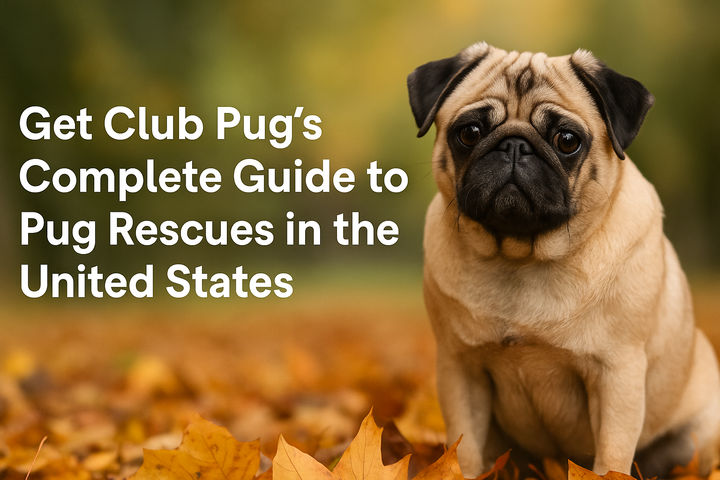Should You Get a Pug from a Breeder or Rescue? Pros & Cons for Future Pug Parents
If your heart is set on adding a pug to your family, one of the most important decisions you’ll make is where to get your pug — from a breeder or a rescue. Both options can lead to a happy, healthy pug life, but they come with different experiences and responsibilities.

If your heart is set on adding a pug to your family, you're already in for a lifetime of snorts, cuddles, and unconditional love. But one of the most important decisions you’ll make is where to get your pug — from a breeder or a rescue. Both options can lead to a happy, healthy pug life, but they come with different experiences and responsibilities.
In this Club Pug guide, we’re laying out the pros and cons of getting a pug from a breeder versus a rescue, so you can make the choice that’s best for you, your lifestyle, and the pug you're welcoming home.
🏡 Getting a Pug from a Rescue: Pros & Cons
Adopting a pug from a rescue organization or shelter is a beautiful way to give a dog a second chance at life.
✅ Pros of Rescuing a Pug
- You’re saving a life. Many rescued pugs are surrendered due to no fault of their own.
- Lower cost. Adoption fees are usually between $100–$500 and include spay/neuter, vaccinations, and microchipping.
- Older dogs available. Perfect if you want to skip the puppy phase (and the potty training).
- Personality is known. Rescues often assess temperament, so you’ll know if your pug is good with kids, cats, or other dogs.
- You support a good cause. Rescue organizations rely on adoption fees and donations to keep saving lives.
⚠️ Cons of Rescuing a Pug
- Limited availability. Purebred pugs go quickly; you may be on a waitlist or need to be flexible.
- Unknown background. You might not know their full health history or past experiences.
- May need extra patience. Some rescues have behavioral or medical needs that require special care or training.
- Not always a puppy. If you're set on raising a pug from day one, puppies are rare in rescues.
🐶 Getting a Pug from a Breeder: Pros & Cons
If you’re looking for a specific age, look, or lineage, working with a responsible breeder might be the right path.
🐶 Getting a Pug from a Breeder: Pros, Cons & What AKC Certification Means
If you’re looking for a specific age, look, or lineage, working with a responsible breeder might be the right path. But not all breeders are created equal — and that’s where AKC certification can help guide your decision.
✅ What Is AKC Certification?
The American Kennel Club (AKC) is a nationally recognized registry that tracks purebred dogs and promotes responsible breeding practices. An AKC-registered pug means the dog's lineage is documented and verified through pedigree records.
However, AKC registration does not guarantee:
- The health of the puppy
- Ethical or humane breeding practices
- The living conditions of the breeder
👉 Important: Many backyard breeders and puppy mills can register litters with the AKC, so registration alone is not proof of quality. Use it as one tool in your breeder evaluation process — not the only one.
✅ Pros of Buying from a Breeder
- You can raise your pug from a puppy.
- Known lineage with documentation and sometimes AKC registration.
- Predictable availability and choice of traits like color or gender.
- Support system from an experienced breeder who may offer lifelong guidance.
⚠️ Cons of Buying from a Breeder
- Cost. Expect to pay $1,500–$4,000+ for an AKC-registered or health-screened pug.
- Vetting is essential. Look beyond the AKC status — request health tests and meet the breeder in person.
- Waitlists. Reputable breeders may breed sparingly, meaning you might wait months for a puppy.
- Ethical considerations. Many pug lovers prefer adopting to reduce overbreeding and support rescue work.
✅ What to Look for in a Breeder (AKC or Not)
Whether the breeder is AKC-affiliated or not, ask for proof of:
- Health screenings (especially for BOAS, eye issues, and joint problems)
- Clean, humane breeding environments
- Transparent communication and vetting of you as a buyer
- References or testimonials from past puppy buyers
AKC certification can add credibility, but it's just one piece of the puzzle. A responsible, ethical breeder will go far beyond the bare minimum.
📋 What to Look for in a Breeder or Rescue
✅ A good breeder will:
- Provide health clearances (especially for BOAS and genetic conditions)
- Let you meet the puppy’s parents
- Ask you questions to ensure a good fit
- Have clean, humane living conditions
✅ A good rescue will:
- Be transparent about the pug’s needs and behavior
- Provide veterinary records
- Do a home visit or thorough adoption interview
- Offer support post-adoption
❤️ So, What’s Right for You?
There’s no one-size-fits-all answer — both breeders and rescues can match you with a wonderful pug. It all comes down to your lifestyle, preferences, and readiness to take on a puppy or help a pug in need.
Whether you choose to adopt or shop responsibly, you’re becoming part of a community that truly understands the joy (and quirks!) of this lovable breed.
🔎 Club Pug Premium Resource:
We’re building a state-by-state directory of reputable pug breeders and pug rescue organizations — available to all premium-tier Club Pug members! Stay tuned.
Club Pug Tip: Want help spotting red flags in breeder listings or preparing your home for a rescue pug? Ask the community in the comments — or request a future deep-dive!



Comments ()